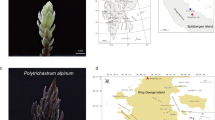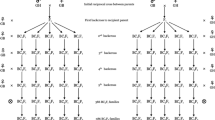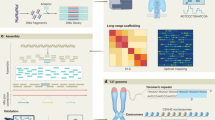Abstract
Chromosomes are key structural and functional components of heredity. Reconstruction of ancestral cell karyotypes (ACKs) and evolutionary trajectories of chromosomes (CETs) can reveal how structural and functional changes in chromosomes have occurred during evolution. The whole-genome duplication integrated analysis toolkit implements a telomere-centric model on the basis of the comparative analysis of gene collinearity within and between plant genomes to reconstruct the ACKs and CETs of many angiosperm plants whose genomes have been complicated by repeated polyploidization and subsequent repatterning. Here we summarize the steps for using whole-genome duplication integrated analysis to infer the gene collinearity within a genome or between genomes and to infer the repeated polyploidization specific to a plant or common to multiple plants or plant families. In addition, we provide an example with three grass genomes. We also describe procedures to infer ancestral chromosomes at key evolutionary nodes, to reconstruct CETs from the deep past to extant plants and to generate event-related hierarchical alignment of multiple genomes, which is realized by deciphering collinear genes produced by different polyploidization or speciation events. The Protocol guides users to infer ACKs and CETs in a plant taxon and between selected plants from different taxa, which is crucial to understand important sources of genetic innovation including chromosome evolution, genome complexity and origination and evolution of duplicated genes. This Protocol requires minimal bioinformatics knowledge, for example, retrieving data from public databases and running Python programs. Completing the protocol with the example data takes around 8 h.
Key points
-
Whole-genome duplication integrated analysis implements a telomere-centric model of chromosome evolution, whereby telomeres are assumed to have a central role in chromosome structural rearrangements during plant evolution. The tool infers gene collinearity within and between plant genomes and uses it to obtain ancestral cell karyotypes and reconstruct evolutionary trajectories of chromosomes.
-
Unlike related tools that rely on gene synteny, whole-genome duplication integrated analysis infers collinear genes that are related to specific polyploidization and speciation events.
This is a preview of subscription content, access via your institution
Access options
Access Nature and 54 other Nature Portfolio journals
Get Nature+, our best-value online-access subscription
$32.99 / 30 days
cancel any time
Subscribe to this journal
Receive 12 print issues and online access
$259.00 per year
only $21.58 per issue
Buy this article
- Purchase on SpringerLink
- Instant access to full article PDF
Prices may be subject to local taxes which are calculated during checkout






Similar content being viewed by others
Data availability
Genome sequences and annotations used in this protocol can be retrieved from the NCBI genome (https://www.ncbi.nlm.nih.gov/datasets/genome). The data for this protocol are wrapped as a zip file named ‘WGDI_protocol.zip’, which is available at http://47.92.161.27:8000/biaoge/backend/download.html. Source data are provided with this paper.
Code availability
WGDI is available via GitHub at https://github.com/SunPengChuan/wgdi-example. Programs used in this protocol and example datasets are included within the ‘WGDI_protocol.zip’ file, which is available at http://47.92.161.27:8000/biaoge/backend/download.html.
References
Jaillon, O. et al. The grapevine genome sequence suggests ancestral hexaploidization in major angiosperm phyla. Nature 449, 463–467 (2007).
Soltis, D. E., Soltis, P. S. & Tate, J. A. Advances in the study of polyploidy since Plant speciation. N. Phytol. 161, 173–191 (2004).
Husband, B. C., Baldwin, S. J. & Suda, J. in Plant Genome Diversity Volume 2: Physical Structure, Behaviour and Evolution of Plant Genomes (eds Greilhuber, J. et al.) 255–276 (Springer, 2013).
Wang, J. et al. Recursive paleohexaploidization shaped the durian genome. Plant Physiol. 179, 209–219 (2019).
Chalhoub, B. et al. Plant genetics. Early allopolyploid evolution in the post-Neolithic Brassica napus oilseed genome. Science 345, 950–953 (2014).
Sato, S. et al. The tomato genome sequence provides insights into fleshy fruit evolution. Nature 485, 635–641 (2012).
Wang, X. et al. The genome of the mesopolyploid crop species Brassica rapa. Nat. Genet. 43, 1035–1039 (2011).
Liu, S. et al. The Brassica oleracea genome reveals the asymmetrical evolution of polyploid genomes. Nat. Commun. 5, 3930 (2014).
Shi, T. et al. The slow-evolving Acorus tatarinowii genome sheds light on ancestral monocot evolution. Nat. Plants 8, 764–777 (2022).
Pont, C. et al. Paleogenomics: reconstruction of plant evolutionary trajectories from modern and ancient DNA. Genome Biol. 20, 29 (2019).
Salse, J. et al. Reconstruction of monocotelydoneous proto-chromosomes reveals faster evolution in plants than in animals. Proc. Natl Acad. Sci. USA 106, 14908–14913 (2009).
Murat, F. et al. Shared subgenome dominance following polyploidization explains grass genome evolutionary plasticity from a seven protochromosome ancestor with 16K protogenes. Genome Biol. Evol. 6, 12–33 (2014).
Sun, Y., Shang, L., Zhu, Q. H., Fan, L. & Guo, L. Twenty years of plant genome sequencing: achievements and challenges. Trends Plant Sci. 27, 391–401 (2022).
Wang, X. et al. Telomere-centric genome repatterning determines recurring chromosome number reductions during the evolution of eukaryotes. N. Phytol. 205, 378–389 (2015).
Zhuang, W. et al. Reply to: evaluating two different models of peanut’s origin. Nat. Genet. 52, 560–563 (2020).
Wang, S. et al. High-quality reference genome sequences of two coconut cultivars provide insights into evolution of monocot chromosomes and differentiation of fiber content and plant height. Genome Biol. 22, 304 (2021).
Zhang, Z. et al. An updated explanation of ancestral karyotype changes and reconstruction of evolutionary trajectories to form Camelina sativa chromosomes. BMC Genom. 21, 705 (2020).
Song, X. et al. The celery genome sequence reveals sequential paleo-polyploidizations, karyotype evolution and resistance gene reduction in apiales. Plant Biotechnol. J. 19, 731–744 (2021).
Xie, D. et al. The wax gourd genomes offer insights into the genetic diversity and ancestral cucurbit karyotype. Nat. Commun. 10, 5158 (2019).
Wang, X. & Wang, Z. Evolutionary genomics model of chromosome number reduction and B chromosome production. SCIENTIA SINICA Vitae 50, 524–537 (2020).
Wang, J. et al. Comparative genomics analysis of rice and pineapple contributes to understand the chromosome number reduction and genomic changes in grasses. Front Genet. 7, 174 (2016).
Wang, J. et al. Deciphering recursive polyploidization in Lamiales and reconstructing their chromosome evolutionary trajectories. Plant Physiol. 195, 2143–2157 (2024).
Sun, P. et al. WGDI: a user-friendly toolkit for evolutionary analyses of whole-genome duplications and ancestral karyotypes. Mol. Plant 15, 1841–1851 (2022).
Murat, F. et al. Karyotype and gene order evolution from reconstructed extinct ancestors highlight contrasts in genome plasticity of modern rosid crops. Genome Biol. Evol. 7, 735–749 (2015).
Cai, J. J. & Osorio, D. in Computational Advances in Bio and Medical Sciences Lecture Notes in Computer Science (eds Bansal, M. S. et al.) Ch. 8, 88–94 (Springer, 2021).
Gao, S. et al. IAGS: inferring ancestor genome structure under a wide range of evolutionary scenarios. Mol. Biol. Evol. 39, msac041 (2022).
Mascher, M. et al. A chromosome conformation capture ordered sequence of the barley genome. Nature 544, 427–433 (2017).
Costanzo, K. B. V. Centromere structure and function. Prog. Mol. Subcell Biol. 56, 515–539 (2017).
Wang, Y. et al. Detection of colinear blocks and synteny and evolutionary analyses based on utilization of MCScanX. Nat. Protoc. 19, 2206–2229 (2024).
Wang, Y. et al. MCScanX: a toolkit for detection and evolutionary analysis of gene synteny and collinearity. Nucleic Acids Res. 40, e49 (2012).
Wang, X. et al. Statistical inference of chromosomal homology based on gene colinearity and applications to Arabidopsis and rice. BMC Bioinform. 7, 447 (2006).
Tang, H. et al. tanghaibao/jcvi: JCVI v0.7.5 (v0.7.5). Zenodo https://doi.org/10.5281/zenodo.846919 (2017).
Zhuang, W. et al. The genome of cultivated peanut provides insight into legume karyotypes, polyploid evolution and crop domestication. Nat. Genet. 51, 865–876 (2019).
Wang, J. et al. An overlooked paleotetraploidization in Cucurbitaceae. Mol. Biol. Evol. 35, 16–26 (2018).
Wang, X. et al. Genome alignment spanning major poaceae lineages reveals heterogeneous evolutionary rates and alters inferred dates for key evolutionary events. Mol. Plant 8, 885–898 (2015).
Song, X. et al. Deciphering the high-quality genome sequence of coriander that causes controversial feelings. Plant Biotechnol. J. 18, 1444–1456 (2020).
Wang, J. et al. Paleo-polyploidization in Lycophytes. Genom. Proteom. Bioinform. 18, 333–340 (2020).
Huang, H. -R. et al. Telomere-to-telomere haplotype-resolved reference genome reveals subgenome divergence and disease resistance in triploid Cavendish banana. Hortic. Res. 10, uhad153 (2023).
Jiang, B. et al. Characterization and heterologous reconstitution of Taxus biosynthetic enzymes leading to baccatin III. Science 383, 622–629 (2024).
Acknowledgements
This work was supported by research grants from the National Natural Science Foundation of China to X.W. (grant no. 32070669) and to Z.W. (grant no. 32000405), the Talented Scientist program from the Tangshan Municipal Bureau Human Resources and Social Security to X.W. (grant no. 16013601) and the Tangshan Science and Technology Program Project (grant no. 21130228) to Z.W.
Author information
Authors and Affiliations
Contributions
X.W. conceived and led the research and prepared the manuscript. B.S., W.L., Y.J., L.Y., T.W., M.Y., J.W., F.H., H.Q., H.Z., Z.W. and Y.J. analyzed the data and prepared the figures; B.S. and X.W. provided the description of WGDI; F.H. and J.W. analyzed the data related to partial monocots and eudicots, respectively, and W.L., Y.J., T.W. and Y.L. improved the programs inferring ACKs and CETs to ensure user-friendly output.
Corresponding author
Ethics declarations
Competing interests
The authors declare no competing interests.
Peer review
Peer review information
Nature Protocols thanks Kai Ye and the other, anonymous, reviewer(s) for their contribution to the peer review of this work.
Additional information
Publisher’s note Springer Nature remains neutral with regard to jurisdictional claims in published maps and institutional affiliations.
Key references
Wang, J. et al. Mol. Biol. Evol. 35, 16–26 (2018): https://doi.org/10.1093/molbev/msx242
Sun, P. et al. Mol. Plant 15, 1841–1851 (2022): https://doi.org/10.1016/j.molp.2022.10.018
Wang, S. et al. Genome Biol. 22, 304 (2021): https://doi.org/10.1186/s13059-021-02522-9
Supplementary information
Supplementary Information
Supplementary Figs. 1–4 and text.
Supplementary Data 1
Original data sets for readers to repeat the analysis described in the manuscript and the Supplementary text.
Supplementary Data 2
A demo for the protocol to run WGDI to infer ancestral chromosomes and evolutionary trajectories to form the chromosomes in extant plants.
Supplementary Data 3
Source data for Supplementary Figs. 1–3.
Source data
Source data of Figs. 3c–g and 6
Statistical source data.
Rights and permissions
Springer Nature or its licensor (e.g. a society or other partner) holds exclusive rights to this article under a publishing agreement with the author(s) or other rightsholder(s); author self-archiving of the accepted manuscript version of this article is solely governed by the terms of such publishing agreement and applicable law.
About this article
Cite this article
Wang, X., Song, B., Liu, W. et al. Comparative genomics approach to infer ancestral cell karyotypes and reconstruct the evolutionary trajectories of plant chromosomes. Nat Protoc (2025). https://doi.org/10.1038/s41596-025-01173-5
Received:
Accepted:
Published:
DOI: https://doi.org/10.1038/s41596-025-01173-5



